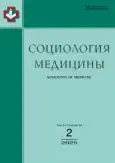Quality of life of older residents of the Grodno region: sex- and residence-specific aspects
- Authors: Surmach M.Y.1, Korneiko P.L.1
-
Affiliations:
- Grodno State Medical University
- Issue: Vol 24, No 2 (2025)
- Pages: 94-101
- Section: MEDICAL SOCIOLOGICAL STUDIES
- URL: https://journal-vniispk.ru/1728-2810/article/view/348609
- DOI: https://doi.org/10.17816/socm645345
- ID: 348609
Cite item
Abstract
BACKGROUND: The population of the Republic of Belarus belongs to the demographically old type, and with the increase in average life expectancy, the trend of population aging is expected to persist. An objective assessment will help identify reserves for improving quality of life and fully realize the potential of individuals aged 60 years and older.
AIM: The work aimed to analyze sex-related and territorial (urban vs rural) differences in quality of life, using the population of the Grodno Region aged 60 years and older as an example.
METHODS: Based on a representative database of the Grodno Region, an analysis of quality of life among individuals aged 60+ was performed, taking into account sex and place of residence. Descriptive, parametric, and non-parametric statistical methods were applied.
RESULTS: The overall quality of life score was 64.48% ± 0.9% in men and 64.13% ± 0.63% in women (p > 0.05 for sex-related differences). Urban residents rated their quality of life higher (64.77% ± 0.61%) compared to rural residents (63.24% ± 0.97%), which was due to a larger proportion of individuals with higher scores and a smaller proportion with average scores of perceived quality of life. The differences were mainly associated with the domains of Physical and Psychological Well-being and Self-perception, to a lesser extent with Social Well-being, whereas Microsocial Support showed no differences between urban and rural residents. The domain Physical and Psychological Well-being demonstrated the lowest values (95% CI 61.52% ± 0.55%), without gender differences but with lower scores among rural residents: 60.47% ± 1.04% vs 62.05% ± 0.64% in urban residents. The Self-perception domain values were 64.89% ± 0.59% in urban residents and 62.91% ± 1.0% in rural residents.
CONCLUSION: The absence of sex-related differences in perceived quality of life in old age indicates equality between men and women regarding factors influencing subjective well-being. Lower overall quality of life scores among rural residents require detailed analysis of underlying causes. It is reasonable to assume that improving self-perception among individuals aged 60+ is possible through the creation of micro- and macro-social environments that promote physical independence and autonomy. In addition to state support, measures of social partnership are necessary. Marketing strategies in Belarusian society should increasingly target the older consumer, whose potential must be maximized under conditions of demographic aging.
Full Text
##article.viewOnOriginalSite##About the authors
Marina Yu. Surmach
Grodno State Medical University
Author for correspondence.
Email: marina_surmach@mail.ru
ORCID iD: 0000-0002-3653-8385
SPIN-code: 3697-5235
MD, Dr. Sci. (Medicine), Professor
Belarus, GrodnoPavel L. Korneiko
Grodno State Medical University
Email: pavelkorneiko@gmail.com
ORCID iD: 0000-0001-8449-296X
SPIN-code: 2480-2402
Belarus, Grodno
References
- GBD 2019 Demographics Collaborators. Global age-sex-specific fertility, mortality, healthy life expectancy (HALE), and population estimates in 204 countries and territories, 1950-2019: a comprehensive demographic analysis for the Global Burden of Disease Study 2019. Lancet. 2020;396(10258):1160–1203. doi: 10.1016/S0140-6736(20)30977-6 EDN: EWPFHL
- Surmach MYu, Korneiko PL. Health-related quality of life of Grodno region population aged 60 and over. Part 1: methodology for research object formation. Issues of organization and informatization of health care. 2024;(1(118)):62–67. EDN: JKNKWB
- Moroz IN, Sikorski AV, Petretto DR, et al. The assesment of public satisfaction with quality of life. Bulletin of Semashko National Research Institute of Public Health. 2020;(4):6–13. doi: 10.25742/NRIPH.2020.04.001 EDN: ZIKRNP
- Reshetnikov AV, Sobolev KE, Marochkina EB. Social portrait and features of the medical behavior of consumers of medical services in the Moscow region health system: a medico-sociological study. Sociology of medicine. 2022;21(2):131–145. doi: 10.17816/socm133673 EDN: CUEFWN
- Prisyazhnaya NV, Dubogray EV, Agapova EG. Health-saving behavior and quality of life of military pensioners of working age in the process of their re-socialization after discharge from military service: qualitative and quantitative study. Sociology of medicine. 2022;21(1):49–57. doi: 10.17816/socm109339 EDN: PPRXDZ
Supplementary files









